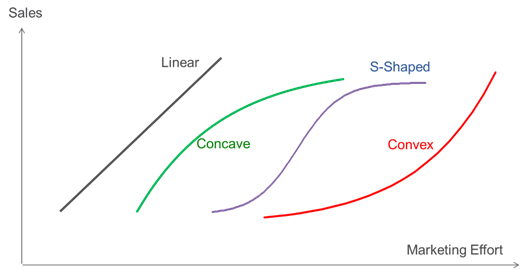What is Continuous Repulsing in Advertising
Market Mix Modelling — Sales Response Function
Exhibit 34.1 Shapes of different sales response functions.
Marketing mix models embody "sales response functions" to relate the effects of marketing activities on sales. The dependence of sales on the different element of the marketing mix is estimated from historical market data using econometric and time series analysis methods. The resulting sales response functions depict the effect of the different elements of the mix on sales.
The functional form specifies the relationship between the dependent variable (sales) and the independent variable (e.g. price, advertising, promotion etc.). It determines the shape of the sales response curve, and reflects the nature of the marketing activity.
Fundamentally there are four basic shapes — linear, concave, convex and S-shape — as shown in Exhibit 34.1.
Constant Returns to Scale (Linear) Models
The simplest functional form is the linear model which represents constant returns to scale:
$$ S=α+βX $$
Where:
S is sales, the dependent variable, and
X is the independent variable representing the marketing effort for the marketing mix element.
α and β are model parameters. α is the intercept — the sales when there is no marketing effort. β is coefficient for X. A unit change in X results in a change of β units in sales.
The linear model is theoretically unsound because it suggests that sales increase indefinitely. However from a practical point of view, for a relatively small operating range, a linear model can provide a satisfactory approximation of the true relationship.
Diminishing Returns to Scale (Concave) Models
One of the most commonly used forms in market mix modelling is the concave shape, which is characterized by diminishing returns to scale as the marketing activity increases. This aligns well with the expectation that as the intensity of discounts, displays and advertising increases, the returns diminish.
The semilog (semi logarithmic) model is an example of diminishing returns to scale function:
$$ S=α+βln(X) $$
Another functional form that meets the diminishing return to scale requirement is the power model:
$$ S=e^α X^β, X>0\,and\,0<β<1.$$
The power model is also known as the constant elasticity model due to its property that the power coefficient is the elasticity of demand of the marketing mix variable X:
$$\epsilon=\frac{\delta S}{\delta X}×\frac{X}{S}=βe^α X^{β-1}×\frac{X}{e^α X^β}=β$$
The most widely used marketing mix model is a variation of the power model, called the multiplicative model:
$$ S=e^α X_1^{β_1} X_2^{β_2} X_3^{β_3} ... X_j^{β_j}, $$
Where X1 to XJ are variables representing the marketing effort for various marketing mix elements, and X1 to XJ > 0.
This nonlinear structural model can be transformed into an estimation model that is linear in parameters by taking logarithms on both sides. The advantage of this transformation, which is shown below, is that the parameters of the original nonlinear model can be estimated using linear-regression techniques.
$$ ln(S)=α+β_1ln(X_1)+β_2ln(X_2)+β_3ln(X_3) ... +β_jln(X_j) $$
The multiplicative form is widely used in marketing mix models such as Nielsen's Scan*Pro, to evaluate promotions.
Increasing Returns to Scale (Convex) Model
The exponential model (S=eαeβX is an example of a convex shaped, increasing returns to scale model. This may apply for price, provided it is represented as 1/P:
$$ S = S_0 e^{-βP}, β>0 $$
The model assumes that the sales response to decreases in price may exhibit increasing returns to scale.
S-shaped Response Model
In the S-shaped response function, sales exhibit increasing returns to scale at low levels and diminishing returns at high levels of marketing effort. This is plausible for advertising which at low levels gets drowned by the noise, and hits an upper limit at very high levels. Besides advertising, the S-shape response function is also used for modelling the effect of shelf space on sales in store.
The S-shape captures the notions of threshold and saturation. Below the threshold, marketing effort has no impact on sales, and above saturation, there is no further increase in sales. Above/below these bounds, consumers become insensitive to the marketing stimuli.
If it truly reflects the response of advertising to sales, the S-Shape response function has implications on how advertising should be flighted — drip versus burst or pulse. An advertising burst is a heavy dose of advertising over a short interval. It would ensure that advertising levels cross threshold levels. In contrast drip or continuous advertising is much lighter weight of advertising spread over a much longer time frame. If thresholds exist, marketers should use less drip advertising and more burst or pulse advertising — an approach that falls between burst and drip, with advertising going on and off air over the weeks.
While conceptually appealing, there is not much empirical evidence to support the existence of an S-shape response to advertising effort. It is hard to prove or disprove considering that historical data tends to lie well within these theoretical upper and lower bounds, i.e. if they exist.
The logistic model depicted below takes a functional form that conforms to the S-shape.
$$ln \left( \frac{S-S_0}{S^0-S}\right)=α+βln(X), \,where \,0 \le S_0 \le S^0 $$
Where, S0 is the intercept and the threshold level, and 0 is the saturation level.
The elasticity of demand, for a variable with an S-shaped response with sales, follows an inverted bell-shape, starting at 0 at threshold level to a maximum, and back to 0 at the saturation level.
A related but rare phenomenon is the notion of supersaturation. It refers to the excessive use of a marketing instrument, such as advertising, that theoretical may repulse consumers, creating a negative response to sales. It is rarely witnessed because marketers' budgets are usually constrained; they operate below saturation levels and well below supersaturation levels. The supersaturation effect can be represented by the quadratic model:
$$S=α+β_1X-β_2X^2$$
Note: To find content on MarketingMind type the acronym 'MM' followed by your query into the search bar. For example, if you enter 'mm consumer analytics' into Chrome's search bar, relevant pages from MarketingMind will appear in Google's result pages.
Source: https://www.ashokcharan.com/Marketing-Analytics/~mx-mmm-sales-response-function.php

0 Response to "What is Continuous Repulsing in Advertising"
Postar um comentário